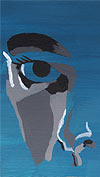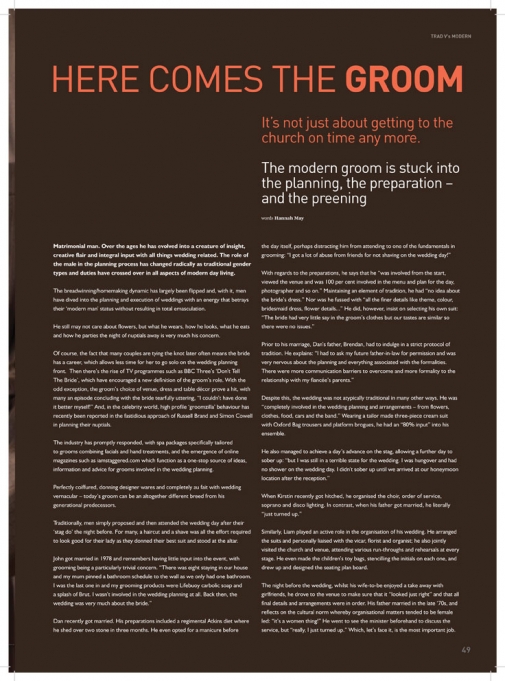
Matrimonial man. Over the ages he has evolved into a creature of insight, creative flair and integral input with all things wedding related. The role of the male in the planning process has changed radically as traditional gender types and duties have crossed over in all aspects of modern day living.
The breadwinning/homemaking dynamic has largely been flipped and, with it, men have dived into the planning and execution of weddings with an energy that betrays their ‘modern man’ status without resulting in total emasculation.
He still may not care about flowers, but what he wears, how he looks, what he eats and how he parties the night of nuptials away is very much his concern.
Of course, the fact that many couples are tying the knot later often means the bride has a career, which allows less time for her to go solo on the wedding planning front. Then there’s the rise of TV programmes such as BBC Three’s ‘Don’t Tell The Bride’, which have encouraged a new definition of the groom’s role. With the odd exception, the groom’s choice of venue, dress and table décor prove a hit, with many an episode concluding with the bride tearfully uttering, “I couldn’t have done it better myself!” And, in the celebrity world, high profile ‘groomzilla’ behaviour has recently been reported in the fastidious approach of Russell Brand and Simon Cowell in planning their nuptials.
The industry has promptly responded, with spa packages specifically tailored to grooms combining facials and hand treatments, and the emergence of online magazines such as iamstaggered.com which function as a one-stop source of ideas, information and advice for grooms involved in the wedding planning.
Perfectly coiffured, donning designer wares and completely au fait with wedding vernacular – today’s groom can be an altogether different breed from his generational predecessors.
Traditionally, men simply proposed and then attended the wedding day after their ‘stag do’ the night before. For many, a haircut and a shave was all the effort required to look good for their lady as they donned their best suit and stood at the altar.
John got married in 1978 and remembers having little input into the event, with grooming being a particularly trivial concern. “There was eight staying in our house and my mum pinned a bathroom schedule to the wall as we only had one bathroom. I was the last one in and my grooming products were Lifebuoy carbolic soap and a splash of Brut. I wasn’t involved in the wedding planning at all. Back then, the wedding was very much about the bride.”
Dan recently got married. His preparations included a regimental Atkins diet where he shed over two stone in three months. He even opted for a manicure before the day itself, perhaps distracting him from attending to one of the fundamentals in grooming: “I got a lot of abuse from friends for not shaving on the wedding day!”
With regards to the preparations, he says that he “was involved from the start, viewed the venue and was 100 per cent involved in the menu and plan for the day, photographer and so on.” Maintaining an element of tradition, he had “no idea about the bride’s dress.” Nor was he fussed with “all the finer details like theme, colour, bridesmaid dress, flower details...” He did, however, insist on selecting his own suit: “The bride had very little say in the groom's clothes but our tastes are similar so there were no issues.”
Prior to his marriage, Dan’s father, Brendan, had to indulge in a strict protocol of tradition. He explains: “I had to ask my future father-in-law for permission and was very nervous about the planning and everything associated with the formalities. There were more communication barriers to overcome and more formality to the relationship with my fiancée’s parents.”
Despite this, the wedding was not atypically traditional in many other ways. He was “completely involved in the wedding planning and arrangements – from flowers, clothes, food, cars and the band.” Wearing a tailor made three-piece cream suit with Oxford Bag trousers and platform brogues, he had an “80% input” into his ensemble.
He also managed to achieve a day’s advance on the stag, allowing a further day to sober up: “but I was still in a terrible state for the wedding. I was hungover and had no shower on the wedding day. I didn't sober up until we arrived at our honeymoon location after the reception.”
When Kirstin recently got hitched, he organised the choir, order of service, soprano and disco lighting. In contrast, when his father got married, he literally “just turned up.”
Similarly, Liam played an active role in the organisation of his wedding. He arranged the suits and personally liaised with the vicar, florist and organist; he also jointly visited the church and venue, attending various run-throughs and rehearsals at every stage. He even made the children's toy bags, stencilling the initials on each one, and drew up and designed the seating plan board.
The night before the wedding, whilst his wife-to-be enjoyed a take away with girlfriends, he drove to the venue to make sure that it “looked just right” and that all final details and arrangements were in order. His father married in the late ‘70s, and reflects on the cultural norm whereby organisational matters tended to be female led: “it's a women thing!” He went to see the minister beforehand to discuss the service, but “really, I just turned up.” Which, let's face it, is the most important job.
www.wedmagazine.co.uk
